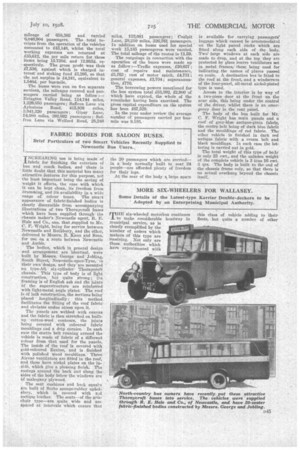MORE SIX-WHEELERS FOR WALLASEY.
Page 99

Page 100

If you've noticed an error in this article please click here to report it so we can fix it.
Some Details of the Latest-type Karrier Double-deckers to be Adopted by an Enterprising Municipal Authority.
THE six-wheeled motorbus continues to make considerable headway in municipal service, as is clearly exemplified by the number of orders which makers of this type are receiving. Not only are those authorities which have experimented with
this class of vehicle adding to their fleets, but quite a number of other municipalities are placing their first orders for such machines.
One of the concerns deriving appreciable benefits from this tendency is Karrier Motors, Ltd., Karrier Works, Huddersfield, which is experiencing a considerable demand for its various six'wheeled models, particularly the doubledeck type which, by reason of its large carrying capacity, is ideally suitable for use in districts where a large number of passengers has to be carried at epecific periods of the day.
One of the latest orders the company has executed for vehicles of this type comprises six smart machines which have been supplied to the Wallasey Corporation ; this authority already operates Karrier single-deck sixwheelers of the WL6-type. The new vehicles are built on the Karrier DD6-type chassis which, as many of our readers will recall, attracted much notice at the Commercial Motor Exhibition at Olympia last year. This model has been fully described in our columns on previous occasions, but it S worth recalling that it incorporates in its
construction au 80-120 h.p. sixc ylinderecl, sleeve valve engine, features of which are a detachable head, a 10 bearing crankshaft and a centrally placed flywheel. The clutch is of the single-plate type and is air cooled, whilst the main shaft and layshaft of the gearbox ere each supported in three largo bearings. The chassis side members are of particularly deep section —actually 1 ft. 1 in. at the deepest part—and are spectacled around the two axles at the rear and downswept to within 1 ft. 8f, ins, of the ground.
Special attention has been given to the question of braking in this model and powerful pneumatic brakes take effect on all four driving wheels, these, of course, being pedal actuated, whilst the hand-brake takes effect on the transmission. Chassis lubrication is a simple matter, as all parts which are normally difficult of access receive their correct quota of lubricant frpm two reservoirs having spring-loaded plungers.
So far as the bodywork of the latest purchases of the Wallasey Corporation is concerned, this has been carried out by Hall, Lewis and Co., Ltd., Park Royal, London, N.W.10. In the construction of this type of body aluminium is used to a large extent, thus resulting in the avoidance of unnecessary weight without sacrificing strength at those vital parts where it is required.
The lower saloon is built to seat 30 people, 'whilst the upper saloon seats 36. All the seats are of the semibucket type and they are upholstered in brown antique hide. In both the upper and lower saloons certain of the windows are made to be lowered, and those in the lower deck are protected by drip ventilators.
016












































































































































































